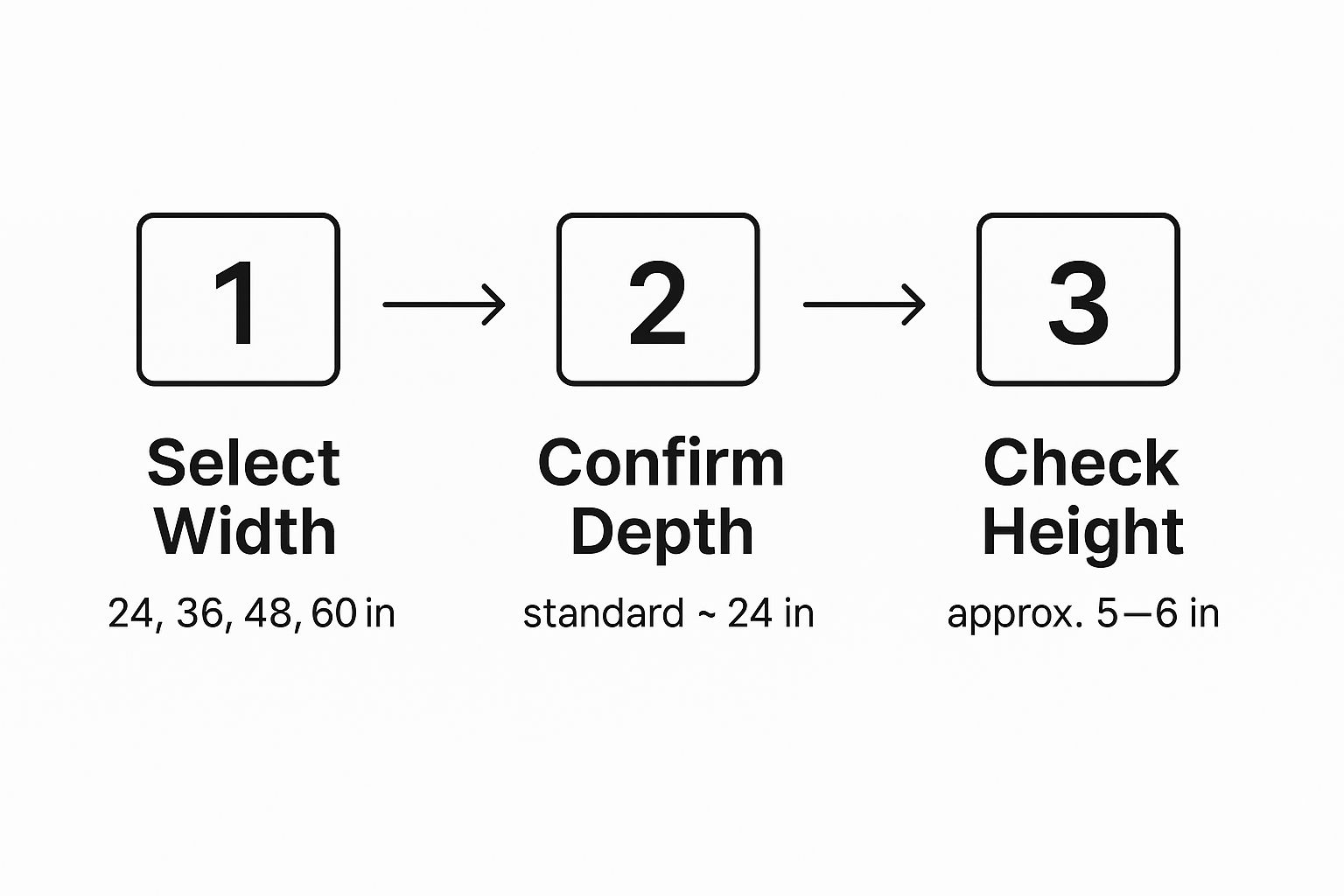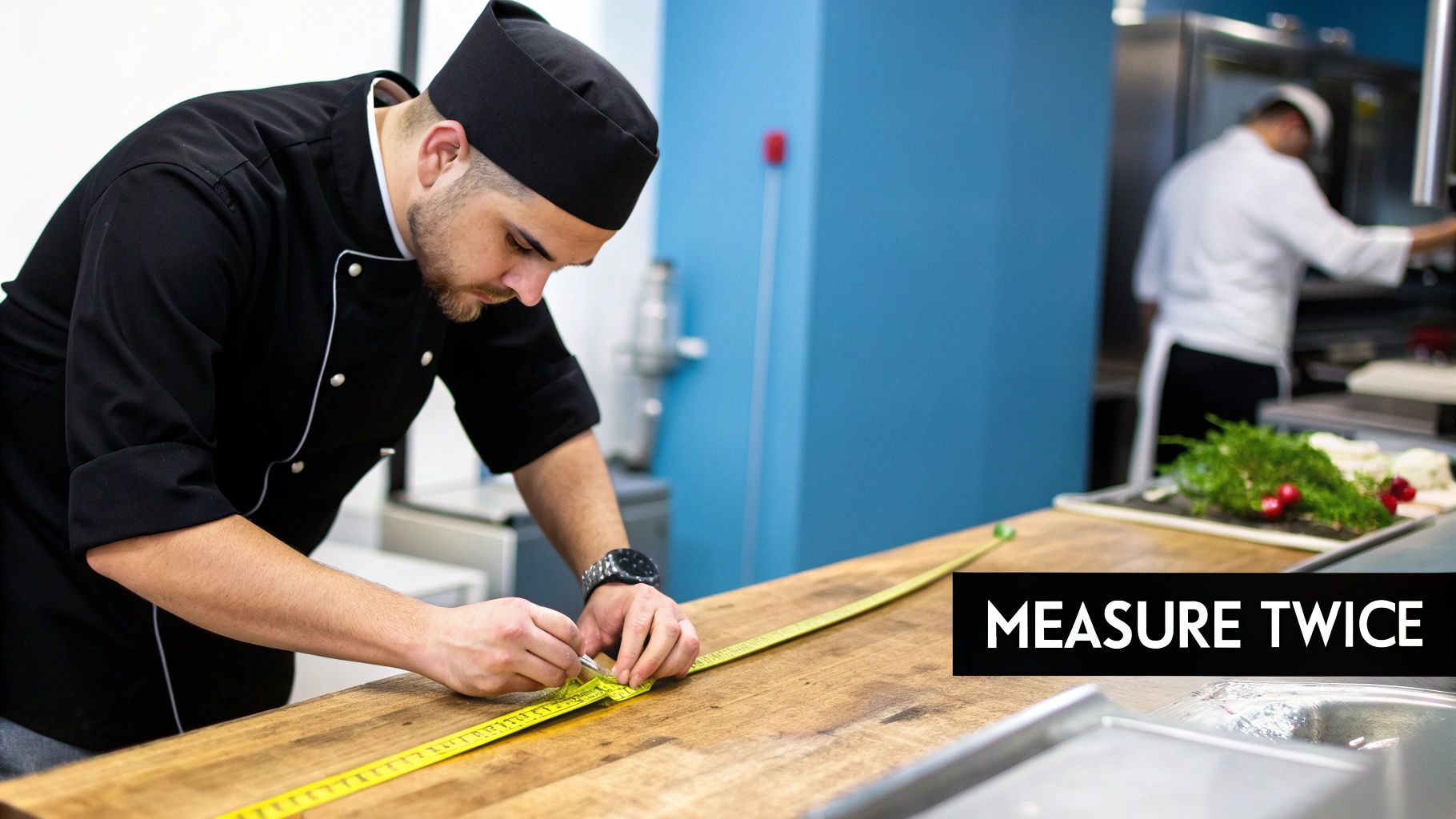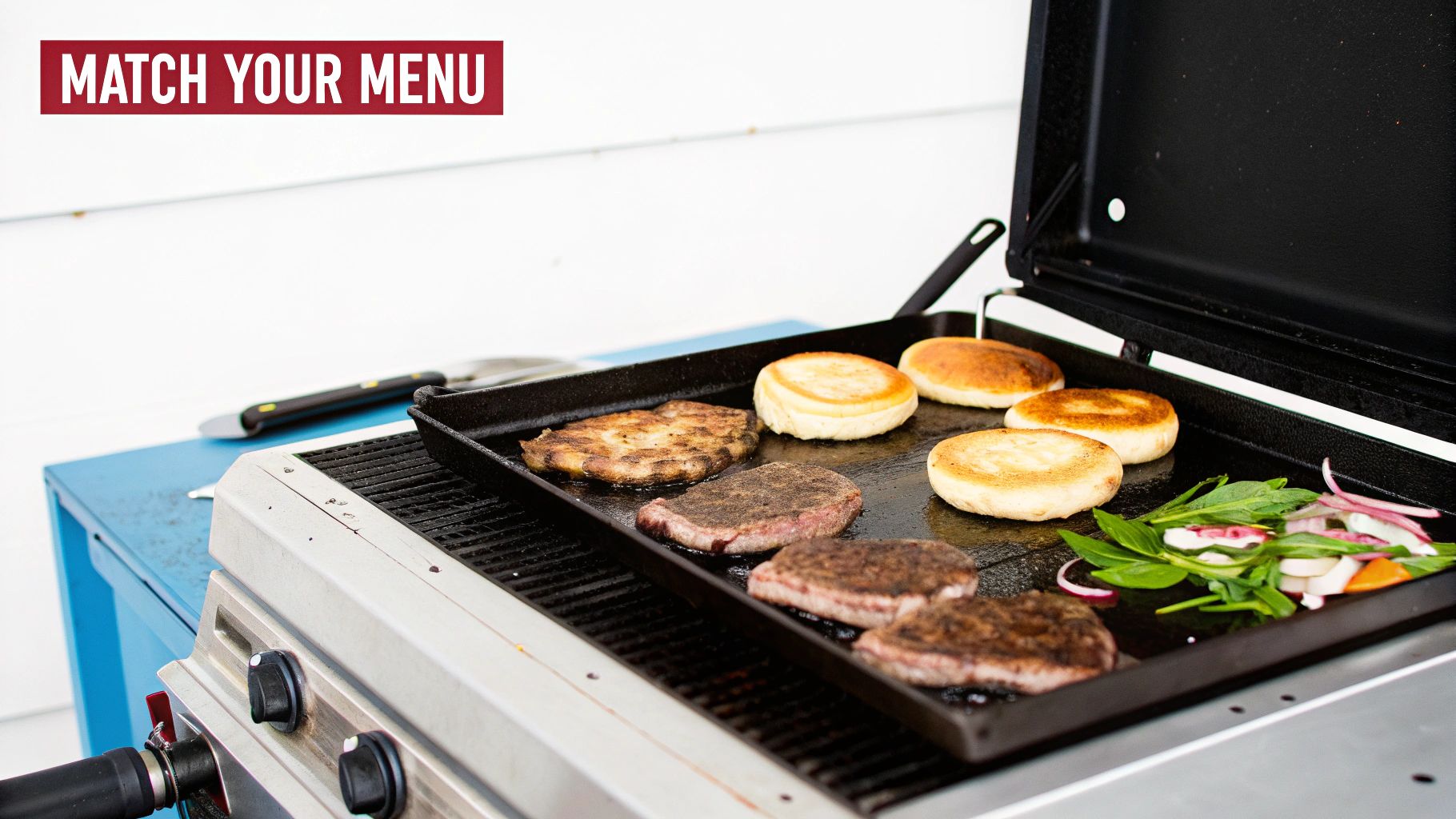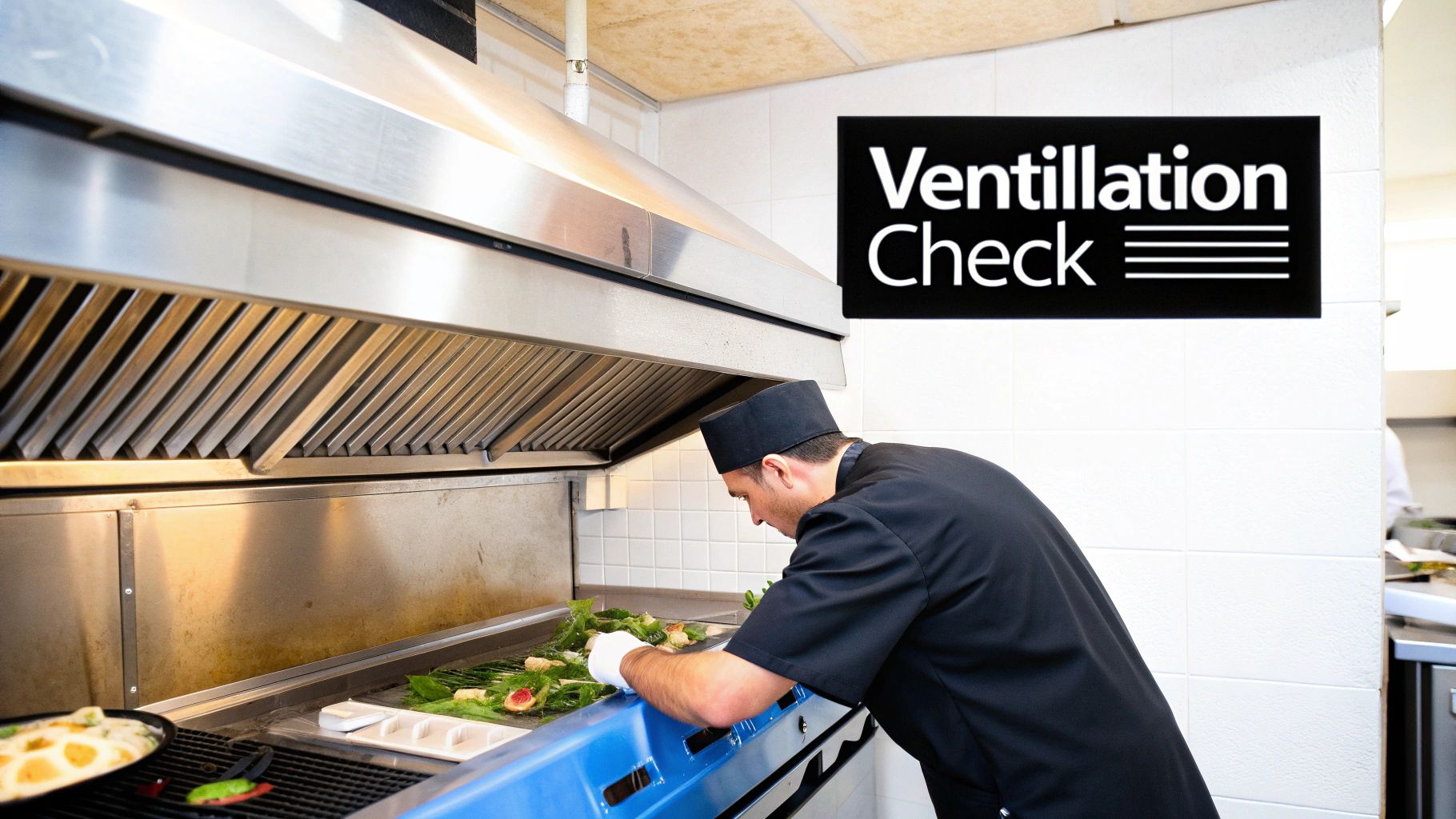
Commercial Griddle Dimensions: The Complete Guide
Walk into any busy commercial kitchen, and you'll see griddles in a few familiar sizes. The most common widths you'll find are 24, 36, 48, and 60 inches. These aren't just random numbers; they're the industry standards that form the foundation of kitchen design. Think of them less as rules and more as the essential tools in a chef's arsenal, each one built for a specific kind of job.
Understanding Standard Commercial Griddle Dimensions
Picking out a griddle is a bigger deal than you might think. The size—width, depth, and height—is the first thing you need to lock down. These numbers don't just determine if the unit will physically fit; they shape your kitchen's entire workflow. A griddle that's too small will create a massive bottleneck during the lunch rush, but one that's too big is just a waste of energy and precious counter space.
Getting the measurements right from the get-go saves you from expensive headaches and ensures your line runs smoothly. It's not just about finding an empty spot and plugging it in. It's about picturing how your team will move and work around this new piece of equipment.
The Three Pillars of Griddle Sizing
Every commercial griddle comes down to three key measurements. Nail these, and you're well on your way to making a smart purchase.
-
Width: This is the big one. Width is all about cooking capacity—how many burgers or pancakes you can fire off at once. A 24" or 36" griddle is perfect for a small café or food truck, while the bigger 48" and 60" models are the workhorses you'll find in high-volume diners and restaurants.
-
Depth: While widths can vary wildly, depth is much more consistent, usually landing somewhere between 24 to 32 inches. This is by design. It ensures that most griddles line up neatly with standard commercial counters and other equipment, giving you that seamless, flush cook line.
-
Height: A typical countertop griddle stands about 12 to 16 inches tall. This is a critical measurement for a couple of reasons. First, it puts the cooking surface at a comfortable, ergonomic height for your chefs. Second, it ensures you have enough clearance under any overhead shelves or ventilation hoods, which is a major safety consideration.
This infographic breaks down the decision-making process into three simple steps.

As you can see, it's a logical flow: start with the width you need for your menu, make sure the depth works for your counter, and finally, double-check the height for both comfort and safety.
How to Accurately Measure Your Kitchen Space

Before you even think about firing up a new griddle, you need to break out the tape measure. Getting your measurements right is the absolute foundation of a smooth installation. It’s what prevents those costly "it doesn't fit" moments and ensures your new gear slots perfectly into your kitchen's rhythm. In a professional kitchen where every inch of the line is prime real estate, the old saying holds true: measure twice, buy once.
And we're not just talking about checking the width of an empty spot. You have to think about the real-world conditions of a busy kitchen—heat, ventilation, and the constant movement of your crew. A griddle that's squeezed in too tightly can quickly become a safety hazard or a bottleneck during the dinner rush.
The Essential Measurement Checklist
To really understand the space you're working with, you need to look beyond the countertop. Run through this checklist to make sure you’ve got all the numbers you need for a safe and functional setup.
- Countertop or Stand Dimensions: Let's start with the basics. Get the exact width and depth of the spot where the griddle will live. Double-check that the surface is perfectly level and strong enough to handle the unit's weight—these things can be seriously heavy.
- Overhead Clearance: Look up. Measure the space between the countertop and anything above it, like a shelf or, most importantly, your ventilation hood. This isn't just about fitting it in; it's a critical factor for fire safety and making sure smoke and fumes are properly pulled away.
- Side and Rear Clearances: Commercial griddles kick out a ton of heat. You absolutely must leave breathing room on all sides to allow for proper airflow and prevent damage to nearby walls or equipment. The manufacturer's spec sheet will list the minimum clearance requirements (usually a few inches), and you need to treat those as gospel.
Don't forget that clearance is for more than just safety—it's also for sanitation. You need to be able to get a hand (and a cleaning cloth) behind and around the griddle to meet health code standards.
Thinking About Workflow and Utilities
With your core measurements in hand, it's time to zoom out and see how the griddle fits into the bigger picture. Where is it in relation to your other critical stations?
For instance, putting a griddle right next to a prep station is a no-brainer. But how far is it from your cold storage? A smooth workflow depends on minimizing the steps your cooks have to take. This is why so many chefs design their lines around key pieces like undercounter refrigerators to keep essential ingredients chilled and right where they need them.
Lastly, map out your utility hookups.
- Gas Lines: For a gas griddle, is the connection close enough? You can't have hoses stretched across walkways, creating a major tripping hazard.
- Electrical Outlets: If you're going electric, make sure you have a suitable, high-amperage outlet within reach. Extension cords are almost always a safety violation in a commercial kitchen, so don't even think about it.
Taking the time to meticulously plan for space, clearance, workflow, and utilities from the start ensures your new griddle will be a workhorse, not a headache. It’s the foundational step that pays off with a smoother installation and a safer, more efficient kitchen for years to come.
Matching Griddle Dimensions to Your Menu

Picking a griddle size isn't just about what fits on your line; it's a core strategic decision that dictates how much food you can pump out. A bigger griddle isn't always better. The right move is to match the cooking real estate to your menu, ensuring you can crush the rush without wasting an inch of space or a dime on energy.
Just think about it. A classic American diner flipping hundreds of pancakes and eggs during the morning rush has completely different needs than a cozy café that just needs to press a few paninis for lunch. That diner is going to need a beast—a 60-inch or even a 72-inch griddle—just to keep up. Meanwhile, the café can get by perfectly with a nimble 24-inch model, saving precious counter space for other gear.
Calculating Your True Cooking Surface Needs
Before you pull the trigger on a new griddle, you need to do a little homework. Look at your menu and, more importantly, your sales data. What are your biggest sellers off the flat top, and how many are you cranking out during your busiest hour? This quick gut-check is what separates a smart equipment purchase from a future production headache.
Let's do some simple math. Say you sling 50 burgers every day during the lunch rush. Each patty is about 4 inches wide. A little 24-inch griddle is going to get overwhelmed fast. You'll barely have room for the patties, let alone space to toast buns or juggle multiple orders. This is exactly why going bigger becomes a direct investment in your bottom line.
This whole idea of matching equipment to output is standard practice in any smart kitchen. We see the same logic with other essential kitchen equipment. It's crucial to select appliances that are built to the correct dimensions to maximize efficiency and workflow. You can dig deeper into foodservice equipment market trends over at Future Market Insights.
The Strategic Advantage of Temperature Zones
Here’s where a wider griddle really starts to pay dividends: temperature zones. With more surface area, you can turn a single piece of equipment into a multitasking powerhouse, boosting your kitchen's efficiency and opening up new menu possibilities.
A wider griddle isn't just about cooking more; it's about cooking smarter. By creating distinct heat zones, a single piece of equipment can sear, sauté, and warm all at the same time, streamlining the entire cooking process.
Picture a busy dinner service with a 48-inch griddle. On one end, your chef can have the heat cranked up for a hard sear on steaks. The middle section can be set to a medium heat for gently sautéing vegetables, while the far end stays on low, perfect for toasting buns or holding finished food for plating. You simply can't achieve that kind of control on a small griddle where the whole surface is one temperature.
Think of it in terms of zones:
- High-Heat Zone: This is your sear station for steaks, burgers, and scallops.
- Medium-Heat Zone: The workhorse for anything needing consistent heat, like pancakes, eggs, and veggies.
- Low-Heat/Warming Zone: Perfect for melting cheese, toasting bread, or keeping finished items at a safe serving temp.
At the end of the day, your griddle’s dimensions should be a direct reflection of your business plan. When you line up the size with your menu, peak volume, and workflow, you’re not just buying a piece of steel—you're making a powerful investment in speed, consistency, and profitability.
Countertop vs. Freestanding Griddle Dimensions
When you're outfitting a kitchen, one of the first big calls you'll make is whether to go with a countertop or freestanding griddle. This decision sets the tone for your entire cook line and workflow. Think of it like this: are you adding a portable desk to an existing room, or are you building a full, custom workstation from scratch?
Countertop griddles are the nimble workhorses of the kitchen. They're designed to be compact and flexible, sitting right on your existing counters or refrigerated bases. Their smaller footprint makes them a no-brainer for kitchens tight on space, food trucks, or any spot looking to add menu items without a massive overhaul.
Freestanding griddles, on the other hand, are the heavy-hitters. These are all-in-one units with their own stand or base, often with built-in cabinet storage or shelving. Since they're self-contained, they're bigger all around and need their own dedicated piece of floor real estate.
Key Dimensional Differences
The real difference comes down to height and depth. Countertop models have a low profile, usually just 12 to 16 inches high, so they can easily sit on a standard-height counter. Freestanding units are built to match the rest of your floor equipment, standing around 36 inches tall for a comfortable, ergonomic working height.
- Countertop Griddles: Great for using vertical space and lining up with other countertop gear like fryers or charbroilers.
- Freestanding Griddles: Perfect for building dedicated, high-output griddle stations, and they often have deeper cooking surfaces for bigger jobs.
This choice has a ripple effect on everything from your utility hookups to your ventilation plan. A freestanding unit needs clear floor access for gas lines or electrical, while a countertop model can often just plug into the existing setup on your line.
Here's a simple way to think about it: a countertop griddle adapts to the space you have, while a freestanding griddle defines it. Your choice dictates how your team will move, cook, and clean around it.
How Dimensions Shape Your Kitchen's Ergonomics
It's not just about the numbers on a spec sheet; the physical form of the griddle impacts how smoothly your kitchen runs. A freestanding model can create a better flow since cooks aren't bumping elbows for counter space. But, stick a countertop griddle on a refrigerated chef base, and you’ve just created an incredibly efficient station where your cook has cold ingredients right at their fingertips.
Manufacturers are always tuning into these needs, which is why you see custom-sized units with slick features popping up. This trend shows how much dimensions really matter, shaping everything from product design to the overall market. As detailed in a market analysis by Contrive Datum Insights, balancing performance and footprint is a huge driver for both manufacturers and buyers.
In the end, it all comes back to your business. A ghost kitchen might thrive on the mix-and-match flexibility of several countertop units. But a bustling, high-volume diner will probably lean on the raw power and dedicated space of a big freestanding griddle.
Critical Installation and Ventilation Requirements

Dropping a new commercial griddle onto your cook line is about much more than just finding an empty spot. Proper installation is a game of inches, and getting it wrong can have serious consequences for safety and performance. The physical size of your griddle is directly tied to critical factors like heat clearance and ventilation—two things that are dangerously easy to overlook.
Think of it like giving a hot engine room to breathe. When a manufacturer tells you to leave 6 inches of clearance from the rear and sides, that’s not a friendly suggestion. It's a non-negotiable buffer zone to keep the intense heat from starting a fire or wrecking your walls and other equipment. Ignoring these specs is a fast track to safety violations and costly equipment failures.
Matching Ventilation Hoods to Griddle Size
One of the most important relationships in your kitchen is between your griddle's dimensions and the ventilation hood above it. A bigger griddle surface puts out way more heat, smoke, and greasy vapor. It's simple, really: a bigger griddle needs a bigger, stronger ventilation system to suck all that gunk out of the air.
Local health and fire codes don't mess around with this. As a general rule, your ventilation hood needs to hang over the cooking surface on all sides, usually by at least 6 inches. This overhang is crucial for capturing all the exhaust, which keeps your air clean and dramatically reduces fire risk. If you try to slide a new 48-inch griddle under a hood that was built for a 36-inch model, you're just asking for trouble with the inspector and creating a hazardous kitchen.
Proper ventilation isn't just a box to check for the fire marshal; it's the lungs of your kitchen. The size of your griddle determines how big those lungs need to be to keep your staff safe and your operation running smoothly.
Global Standards and Local Codes
This need for precise dimensions isn't just a local quirk; it's a universal standard in the appliance world. You see it everywhere, from massive commercial kitchens to residential homes. The fact that major appliance manufacturers all build to predictable sizes shows how much the global market depends on standardization.
This consistency helps ensure that whether you're outfitting a small diner or a five-star restaurant, the rules for safe installation are the same. Your crew's safety and ability to move around the line depend on respecting these dimensional guidelines. And it's not just griddles—other equipment like commercial refrigerators are also designed to fit neatly into a standard kitchen setup.
Ultimately, taking the time to match your griddle's size with the right clearance and ventilation is a must-do. It’s the foundation for a kitchen that is safe, efficient, and free from the headaches of code violations and accidents.
Common Questions About Commercial Griddle Dimensions
Even after you’ve measured your space twice and checked it against your menu needs, a few questions can still pop up. It's totally normal. We hear them all the time from chefs and kitchen managers trying to get it just right.
Think of this as your final checklist before pulling the trigger. We'll tackle the most common questions we get, giving you clear, no-nonsense answers so you can buy with total confidence.
What Is the Standard Depth for a Commercial Griddle?
While everyone focuses on the width, the depth is the dimension that makes your cook line feel seamless. For most commercial griddles, the industry standard depth is between 24 and 32 inches. This isn't an accident—it's designed that way so your new griddle will sit perfectly flush with your other standard equipment, like ranges and prep tables.
That uniformity is a huge deal in a pro kitchen. It creates a smooth, efficient workspace and prevents the griddle from jutting out, which can kill your workflow and even be a safety risk during a busy service.
Can I Use a Smaller Griddle for a High-Volume Restaurant?
It's tempting to try and save a little space—or a few bucks—by going smaller, but for a high-volume spot, that's a classic rookie mistake. A 24-inch or even a 36-inch griddle will instantly become a bottleneck when the tickets start flying. You'll slow down your entire line and end up with frustrated cooks and unhappy customers.
For a busy kitchen, you need the real estate a 48-inch or 60-inch model provides to handle the rush without breaking a sweat.
The right griddle size isn't just about fitting into a gap in your line; it's about matching your kitchen's actual output. Skimping on size will cost you way more in lost efficiency and revenue than you'd ever save on the initial purchase.
How Do I Know If I Need a Thermostatic or Manual Griddle?
This one comes down to what you're cooking. Your menu will tell you everything you need to know.
- Manual Griddles are the workhorses for simple, high-heat jobs. Think smash burgers or searing off steaks. They have basic low, medium, and high settings and get the job done.
- Thermostatic Griddles are all about precision. You can dial in an exact temperature, which is a must-have for anything delicate like pancakes, eggs, or seafood that needs consistent, even heat to cook properly.
At the end of the day, a thermostatic model gives you more flexibility. Precise control is just as critical in other kitchen equipment, which you can see when looking at options for an undercounter freezer.
Ready to find the perfect griddle that fits your kitchen's dimensions and menu needs? At Griddles.com, we specialize in high-quality commercial cooking equipment designed for durability and performance. Explore our complete collection of commercial griddles today at https://griddles.com and build the efficient, high-output cook line your business deserves.
